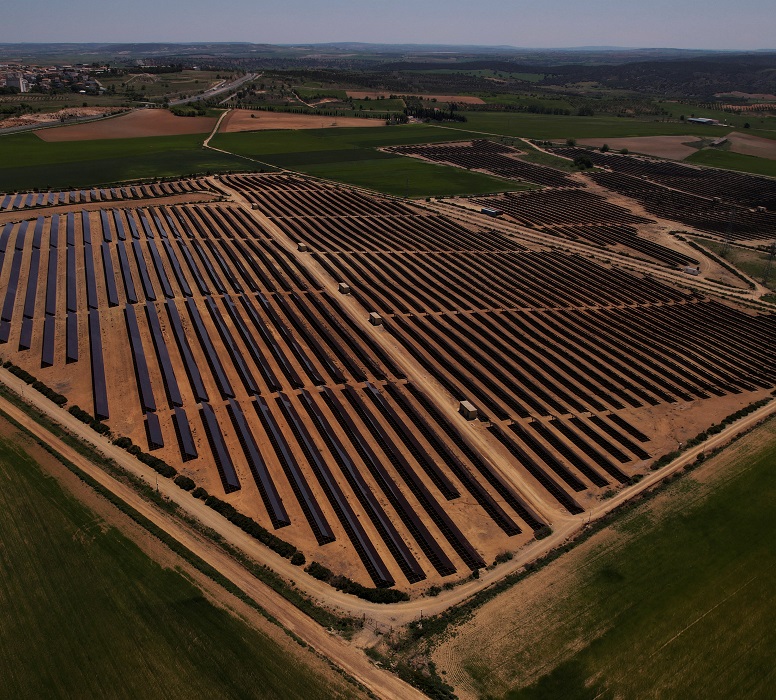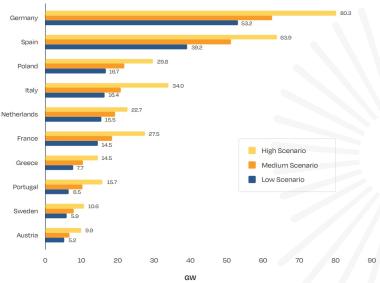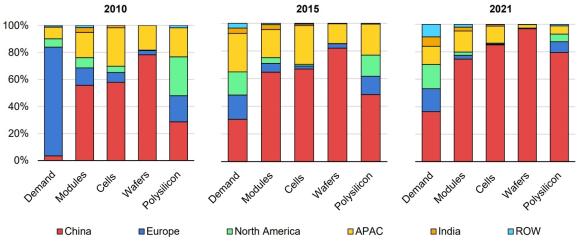Spain hikes solar target to 76 GW; US solar factory jobs to hit 120,000
The solar news you need to know.

Related Articles
Spain hikes solar, wind targets in draft climate strategy
Spain has raised its solar and wind targets in an ambitious plan to generate 81% of the country's electricity from renewables by 2030.
The draft climate strategy published on June 28 doubles the solar target from 39 GW to 76 GW and sets a wind power target of 62 GW by the end of the decade, up from the previous 50 GW target. European Union members had until the end of June to submit their latest carbon emissions targets to the European Commission (EC).
Forecast largest solar markets in the EU in 2023-26
(Click image to enlarge)
Source: SolarPower Europe, December 2022
Spain has the highest solar yields in Europe, good land availability and is Europe's most attractive market for corporate renewable energy power purchase agreements (PPAs). The government is also planning to launch its first offshore wind tenders and aims to install 3 GW of floating wind by 2030.
Spain's latest strategy sets a slightly higher storage target of 22 GW and the country will seek to install 11 GW of electrolysers to produce green hydrogen, up from a previous target of 4 GW. It also plans to double the target for biogas production to 20 terawatt hours (TWh).
The new goals will allow the country to cut greenhouse gas emissions by 32% from 1990 levels, up from an earlier target of 23%.
Spain estimates that it will need investments of 294 billion euros ($322 billion) to hit these targets.
Spanish PM unveils community solar plan in pre-election pledge
Spain's socialist Prime Minister Pedro Sanchez has pledged to implement a new law that would allow local residents to decide the location of new solar and wind farms in a co-ownership arrangement where they would benefit from profits.
Sanchez is trailing in the opinion polls ahead of this month's general election in Spain and his pledge aims to remove opposition to solar and wind projects that is holding back growth.
Local opposition and lengthy permitting processes can delay renewable energy projects by several years or derail projects entirely.
Spain's opposition People's party (PP), which is leading in the polls, said it would introduce a fee for new renewable energy projects to cover administrative costs and speed up processing. The party also favours extending the use of the country's nuclear power plants.
Portugal doubles solar target in EU filing
Portugal has doubled its solar target to 21 GW by 2030 in national energy targets sent to the European Union on June 30.
Portugal currently operates around 3 GW of solar power and will need to install an equivalent capacity every year to reach its target.
In its latest goals, Portugal aims to reduce greenhouse gas emissions by 55% by 2030 based on 2005 levels, compared with a previous target of 45%-55%.
By 2030, Portugal aims to generate 85% of annual electricity demand from renewable sources, compared with 60% in 2022. The country benefits from a large hydroelectric fleet but much of the new capacity will come from solar and wind.
The government forecasts renewable energy capacity will rise to 42.8 GW by 2030, compared with a previous target of 27.4 GW.
US solar manufacturing jobs to hit 120,000 within 10 years
U.S. solar manufacturing employment is forecast to triple to 120,000 jobs by 2033 as deployment soars and the Biden administration's Inflation Reduction Act boosts the business case for new factories, the Solar Energy Industry Association (SEIA) said in a statement on July 3.
Until now, most U.S. solar projects have relied on imports from Asia, but international supply risks have worsened since the coronavirus pandemic. Customs delays, uncertainty over tariffs and soaring global demand have hiked import costs and with U.S. deployment set to soar, more developers are seeking domestic products to reduce delivery risks.
The U.S. had only 8 GW/year of module production capacity at the end of 2022, around one third of annual solar installations and a fraction of the installations required to meet President Biden's decarbonisation goals.
Solar manufacturing capacity by country, region
(Click image to enlarge)
Source: International Energy Agency's Report on Solar PV Global Supply Chains, August 2022
The inflation act, signed by the President in August, offers tax credits for clean tech manufacturing as well as renewable energy projects, improving the business case for U.S. factories.
By March, solar companies had announced plans for 47 GW of new module manufacturing capacity, SEIA said in an earlier statement.
In an emerging trend, large solar developers are investing in new factories to minimise supply risks.
Invenergy, the largest independent renewable energy developer in the U.S., is building the country's biggest solar panel factory in Ohio.
The 5 GW/year facility will be developed with Chinese partner Longi and Invenergy will be the majority owner and anchor customer of the facility, purchasing 40% of all output, an Invenergy spokesperson told Reuters Events in April.
Reuters Events


